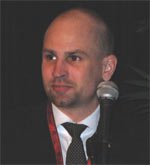Manual, navigated ACL reconstruction techniques yield similar clinical results
However, grafts in the navigated group tended to show better remodeling on 2-year MRI evaluation.

WASHINGTON — New research shows no advantage in correct tibial tunnel placement with computer-navigated ACL reconstruction compared to manual procedures, but indicates better graft remodeling in computer-assisted cases.
In a prospective randomized study, Dominick Endele, MD, and colleagues examined 40 athletes at approximately 24-months follow-up who underwent either manual ACL reconstruction or ACL reconstruction assisted with the OrthoPilot computer navigation system (Aesculap AG). The investigators found no significant differences between the groups regarding IKDC 2000, Tegner and Lysholm scores at the follow-up.
MRIs showed that both groups had an average tibial tunnel placement at 46% of the maximal diameter of the tibia. The investigators also found no significant difference between both groups regarding possible intercondylar roof impingement.
In addition to examining the tibial insertion placement and potential for intercondylar roof impingement, the investigators also used MRI to assess graft appearance approximately 24 months postsurgery.
However, “MRI evaluation revealed better graft remodeling after 24 months [in the navigation group]. Computer navigation did not make any additional improvements to the correct tibial drilling tunnel placement in our study,” he said.
|
Image: Brockenbrough G, Orthopedics Today |
For more information:
- Dominick Endele, MD, can be reached at Sportsclinic Stuttgart, Clinic for Orthopaedic Surgery and Sportstraumatology, Taubenheimstrasse 8, Stuttgart, Germany 70372; +49-711-5535-0; e-mail: dominick.endele@sportklinik-stuttgart.de. He has no direct financial interest in any product or company mentioned in this article.
Reference:
- Endele D, Mauch F, Becker U. Anterior cruciate ligament (ACL) reconstruction with and without computer navigation: A clinical and MRI evaluation two years after surgery. Paper #SS-31. Presented at the 27th Annual Meeting of the Arthroscopy Association of North America. April 24-27, 2008. Washington.

